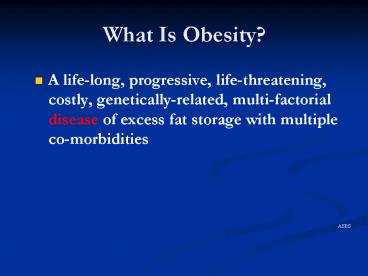What Is Obesity? - PowerPoint PPT Presentation
1 / 26
Title:
What Is Obesity?
Description:
Sacramento Bariatric Different? Integrated program modeled after NIH and ASBS criteria. ... Results will be pooled and compared to national data ... – PowerPoint PPT presentation
Number of Views:19
Avg rating:3.0/5.0
Title: What Is Obesity?
1
What Is Obesity?
- A life-long, progressive, life-threatening,
costly, genetically-related, multi-factorial
disease of excess fat storage with multiple
co-morbidities
ASBS
2
What Is Morbid Obesity?
- Clinically severe obesity at which point serious
medical conditions occur as a direct result of
the obesity - Defined as gt200 of ideal weight, gt100 lb
overweight, or a Body mass index of ?40
3
Obesity and Mortality Risk
2.5
2.0
MortalityRatio
1.5
1.0
VeryLow
VeryHigh
Moderate
Low
Moderate
High
0
20
25
30
35
40
BMI
Gray DS. Med Clin North Am. 198973(1)113.
4
Obesity Related Co-Morbidities
- Type II Diabetes
- Hyperlipidemia
- Hypertension
- Cardiac Disease
- CAD/CHF/LVH
- Respiratory Disease
- Sleep apnea
- Obesity hypoventilation syndrome
- Degenerative arthritis
- Depression
- Pseudotumor cerebri
- GERD
- Nephrotic syndrome
- Pre-eclampsia
- Infertility
- Infectious complications
- Stress incontinence
- Venous stasis ulcers
- Hernias
5
Medical Co-Morbidities Resolved after
Bariatric Surgery
Wittgrove AC,Clark GW. Laparoscopic Gastric
bypass roux-n-y-500 patients. Obes Surg 2000.
And others.
6
Non-Medical Co-Morbidities
- Physical
- Economic
- Psychological
- Social
7
Why Surgery?
- Diet and exercise are not effective long term in
the morbidly obese - Surgery is an accepted and effective approach
- Medical co-morbidities are improved/resolved
- Surgical risk is acceptable vs. risk of long-term
obesity
8
NIH Consensus Conference 1991
- Surgery is an accepted and effective approach
that provides consistent, permanent weight loss
for morbidly obese patients - Surgery indicated in patients with
- BMI of 40 or over
- BMI of 35-40 with significant co-morbidity
- documented dietary attempts ineffective
9
Who Is a Surgical Candidate?
- Meets NIH criteria
- No endocrine cause of obesity
- Acceptable operative risk
- Understands surgery and risks
- Absence of drug or alcohol problem
- No uncontrolled psychological conditions
- Consensus after bariatric team evaluation
- Surgeon/Dietician/Psychologist/Consultant
- Dedicated to life-style change and follow-up
10
Roux-en-Y Gastric Bypass
- Combination
- Most frequently performed bariatric procedure in
the US - First done in 1967
- Laparoscopically since 1993
- 60-70 EBW 14yr follow-up
ASBS
11
How Does the Roux-en-Y Work?
- Surgery factors
- restriction of meal size
- dumping syndrome
- some malabsorption
- decreased appetite
- Patient factors
- calorie intake
- calorie expenditure
12
Results of Gastric Bypass
- Longest and most thorough follow-up
- Significant and durable weight loss
- Control of adult onset diabetes mellitus
- Control of hypertension
- Long term improvement in health and physical
functioning
Results achieved in most but not all cases.
Degree of improvements vary by individual
13
Laparoscopic Adjustable Gastric Banding
- Restrictive
- Good results in Europe and Australia
- Inamed Lap Band FDA approved 6/01
- 40-55 EBW Loss
14
How does the Band work?
- Surgery Factors
- Restriction of meal size
- Decreased appetite
- Patient Factors
- Decreased calorie intake
- Increased calorie expenditure
15
Advantages of Laparoscopy
- Fewer wound complications/infection
- Decreased rate of incisional hernias
- Less pain and faster recovery
- Surgeon has better view of the anatomy
- Quicker return to work/activities
- Shorter hospitalization
Nguyen 2001, Wittgrove 2000, Schauer 2000, Watson
1997
16
Hospital Course
- Laparoscopic Bypass 2-3 days
- Open Bypass 4-7 days
- Gastric Band overnight stay
- Swallow study performed day 1-3
- Liquid diet started
- Home when able to tolerate 3-4 oz/hour
17
Results of Bariatric Surgery
- Weight loss
- Reduction or improvement in co-morbidities
- Increased longevity
- Improved Quality of Life
- health
- social
- personal
- work
18
Lifetime supplements are necessary to prevent
- Iron Deficiency Anemia
- Folate Deficiency
- Vitamin B-12 Deficiency
19
Complications of Gastric Bypass
- Early complications
- intestinal leakage
- acute gastric remnant dilatation
- obstruction
- cardiopulmonary
- MI, PE, pneumonia, atelectasis
- Late complications
- anastomotic stricture (510)
- anemia, B12 deficiency, Ca deficiency
Chapin 1996
20
How are good results achieved?
- Follow ASBS recommendations
- Surgeon and Hospital commitment
- Dedicated bariatric team
- Comprehensive care
- Lifelong follow up
- Database management
21
Weight Loss Program Team
- Surgeon
- Nurse Practicioner
- Bariatric Coordinator
- Registered Dietician
- Clinical psychologist
- Exercise Specialist
- Office support staff
22
Will My Insurance Pay for This Procedure?
- Each insurance plan has its own provisions and
exclusions - Contact your employer and ask if your insurance
has coverage for treatment of morbid obesity - What does coverage really mean?
23
What Happens if My Insurance Company Denies My
Request?
- You have the right to appeal
- Use supportive documentation from your PCP and
surgeon (receipts, programs, gym memberships,
ect.)
24
How Long Does it Take to Pre-Authorize My Surgery?
- Each insurance company has their own set of rules
- They commonly request more information before
approving or disapproving - The process takes from 1 hour to 2 weeks, and as
long as months
25
What Makes Sacramento Bariatric Different?
- Integrated program modeled after NIH and ASBS
criteria. - Life-long commitment for patient access and
follow-up - Multidisciplinary resources for post-surgical
needs - Results will be pooled and compared to national
data - Internet community and private bulletin boards
for patients. - Emphasis on SAFETY and RESULTS!
26
Final Words
- Surgery is only a tool
- Patients must commit to lifelong changes in
diet - and behavior
- Think seriously about options
- We are here to help































